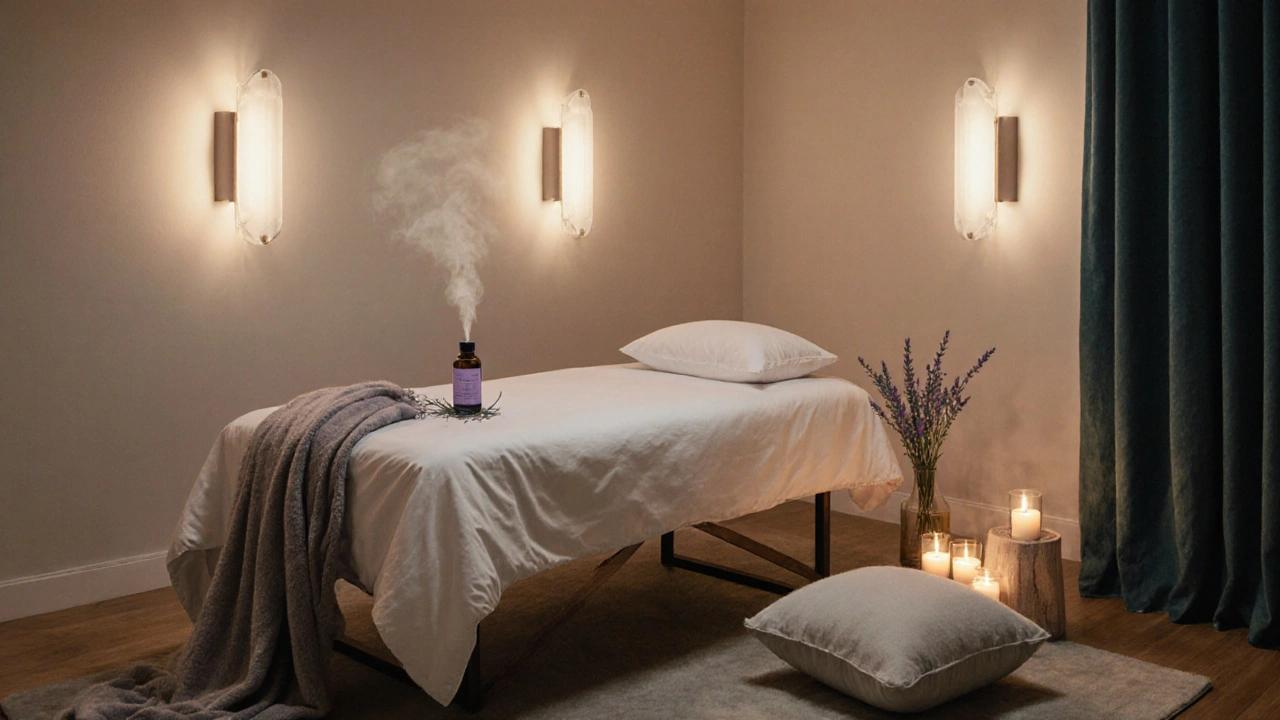Full Body Massage for Pain Relief: Benefits, Techniques & Where to Find Services

Why Full Body Massage is the Secret Weapon for Pain Relief
Ever find yourself clenching your shoulders after a stressful day or rubbing your lower back when you stand up too fast? You're not alone. Our bodies hold tension like a hoarder who’s never heard of spring cleaning. So it shouldn’t be a shock that one of the oldest healing practices on earth—yes, massage therapy—still thrives in our digital world. Full body massage isn’t just about feeling fancy on a day off; it’s a proven powerhouse for pain relief, stress reduction, and even better sleep. Research from the National Center for Complementary and Integrative Health shows more than 19% of adults in the U.S. tried some form of massage in the past year, with pain control being the top reason.
Picture this: You step into a room that smells like lavender and sandalwood, soft music hums in the background, and someone who actually knows what they're doing kneads away all the tension you've been carrying. Hours later, you walk out feeling like you got your body swapped for a new, pain-free model. That’s the magic. Now, massage isn’t some miracle cure-all, but there’s plenty of science behind its powers: A well-done full body massage increases blood flow to tired muscles, reduces cortisol (the stress hormone), and encourages your brain to release feel-good endorphins. A survey in the Journal of Alternative and Complementary Medicine found that people getting weekly massages had “significantly less back pain and improved mobility” compared to people who didn’t.
Ever wonder what makes a massage “full body,” anyway? It's all about covering your major muscle groups from head to toe. Swedish and deep tissue techniques are the main players, but a solid session might also include stretches, joint movements, or even gentle pressure on trigger points. It’s like a reboot for your whole system. And don’t just take my word for it. Chronic pain patients in a 2022 Harvard Health study said that, after a series of weekly massages, their pain intensity dropped by nearly 30%. One client described it as "pressing the reset button" on their pain. I mean, who wouldn’t want that?
Here’s a little secret: full body massage doesn’t just tackle physical pain. If your brain feels fried and your nerves are shot, an hour on the table can settle your mind, ease anxiety, and actually help you sleep better. According to Dr. Tiffany Field of the Touch Research Institute, “Massage relaxes the nervous system and lowers blood pressure in people with chronic stress.” It won’t solve every problem, but it might help you face them with a clearer mind and a lot less tension in your neck.
So, whether you’re a weekend warrior, sitting at a desk 9-to-5, or just want to treat yourself, keep reading. There are super practical tips, expert-backed data, and even a cheat sheet on picking the right type of massage for you. By the end, you'll know all the ins and outs, plus a little bit of spa gossip (because, why not?).

How Full Body Massage Works for Pain Relief: Benefits, Methods, and Real Results
Okay, let’s dig into the nitty gritty. How does a full body massage actually help with pain? It’s all about what’s happening under the skin. When a therapist works your muscles—especially those spots you didn’t even realize were tight—they’re physically breaking up knots and easing adhesions, which are bands of painful, stuck connective tissue. Swedish massage uses long, flowing strokes, usually with oils, which helps move blood and lymph fluid around, sort of like giving your circulation a turbo boost. Deep tissue goes even further, using firm pressure and slow strokes to target the deeper layers of muscle and fascia (the connective sheet under the skin). This is where the magic really happens for folks with chronic pain or injuries.
One of the most jaw-dropping facts? Full body massages ramp up those “feel good” chemicals in the brain: serotonin, dopamine, endorphins, you name it. A 2023 study published in Pain Medicine Journal reported that after just four weekly sessions, back pain patients enjoyed a 40% boost in endorphin levels—and their reported pain went down almost as much. On top of this, massage tones down pathways responsible for the pain-spasm-pain cycle. You know that tight spot in your back that seems to trigger even more pain over time? Massage helps break that loop, so your body can catch a break and heal properly.
Not every massage is created equal. Here’s a whirlwind tour of popular types (plus some advice for picking a style that fits your pain):
- Swedish Massage: The classic. Great for beginners, general tension relief, and anyone looking for an all-over reset.
- Deep Tissue Massage: More pressure, more focus on chronic or intense skeletal muscle pain. Excellent for athletes or anyone with “old” injuries.
- Sports Massage: Mixes techniques and stretches, specifically tailored for active folks wanting to recover faster or prevent injuries. Uses a combo of Swedish, deep tissue, and stretching.
- Trigger Point Therapy: Targets those small, maddening knots (think ‘ouch, that’s the spot!’ moments) with intense, direct pressure.
- Hot Stone Massage: Warm stones placed strategically, which transfer heat deep into the muscle—and yeah, it feels as good as it sounds.
People usually notice perks beyond just pain control: improved mobility, mood boosts, better sleep, fewer headaches, and less anxiety. The CDC released in 2024 that over 60% of massage clients cited “improved ability to participate in daily activities” as a top benefit. Every person’s story is different, but here’s a real example from Sara, a busy mom in Philadelphia: "I used to wake up every morning with a tension headache from bracing my neck all night. After a series of weekly massages, I almost forgot what that pain felt like."
But before you book, it helps to know a little about what actually happens. When you show up for a session, you’ll usually be asked about your health, pain areas, and massage goals. After you settle in (usually in just your underwear, but always with heaps of sheets or towels for privacy), the therapist uses oils or lotion to work through your muscles. You can—and should—tell them if something hurts, feels weird, or if you want more or less pressure. It's YOUR time; don’t feel you need to tough it out if a particular technique isn’t helping. Most sessions last 60 or 90 minutes, and the experience is a mix of gentle kneading, targeted pressure, stretches, and “wow, I didn’t know my calves were so tight” discoveries.
Ready for some numbers? Here’s a quick table breaking down benefits reported by people after full body massage (based on a 2024 global survey):
| Benefit | % Reporting |
|---|---|
| Pain Reduction | 82% |
| Stress Relief | 76% |
| Improved Sleep | 68% |
| Better Mobility | 57% |
| Fewer Headaches | 45% |
You probably want to know: “Is it safe?” For most people, the answer’s a big yes. But if you’re dealing with certain health conditions (think recent surgery, deep vein thrombosis, bleeding disorders, or advanced osteoporosis), check with your doc before making an appointment. Communicate with your therapist, hydrate after—you’d be surprised how thirsty you get—and don’t be shy about giving feedback. And honestly, don’t expect a total cure in one go. Long-term problems need regular care to untangle. If you’re serious about pain management, regular monthly or biweekly massages are where the game-changing benefits show up.
According to Dr. Richard Harris, integrative medicine specialist: “Consistent, skilled massage reduces inflammation and increases recovery speed for common musculoskeletal injuries.”

How to Find the Best Full Body Massage for Pain Relief Near You
If you’ve ever tried to Google ‘massage therapist near me,’ you might be shocked at how many choices there are—and how hard it is to pick the right one. So how do you find someone who’s actually skilled and professional—not just good at making a website? First, look for therapists who are licensed and certified. In the US, make sure they're licensed by your state board and have at least 500 hours of training. Extra points for specialties like sports, orthopedic, or medical massage. Scour real-world reviews (not just the ones on the therapist’s own site) and check sites like Google Maps, Yelp, or real community forums. Some therapists even offer intro deals so you can try a session without committing long-term.
When you're choosing a clinic or spa, pay attention to their vibe—both online and in person. Cleanliness, honest communication, and a willingness to listen to your needs matter. Don’t be afraid to ask questions like:
- “Are you experienced with chronic pain or specific injuries?”
- “What’s your main technique or specialty?”
- “Do you take a health history before the first session?”
You can also search by location—for example, if you're in a particular city, try searching "full body massage New York chronic pain." Most reputable places provide detailed descriptions on their websites too, so check for info on specialties, staff qualifications, and how they sanitize between clients.
Pricing varies a ton, depending on where you live, the therapist's experience, and session length. In the US, expect around $80-125 for a 60-minute session and $110-175 for 90 minutes. Many places offer loyalty programs or discounts for buying several sessions at once. Booking is usually done online these days, but don’t be shy about calling to discuss your needs first. If it's your first massage, look for day spas, wellness centers, or clinics that offer comprehensive introductory overviews—think of it as a no-pressure way to get started.
And if you’re worried about safety, especially post-pandemic, check for clear info on changing linens, sanitizing hands and tools, and staff masking policies. It’s your body—you get to be picky. Want a comparison to see how full body massage stacks up to self-care at home? Check out this quick table:
| Full Body Massage | Self-Massage/Home Care | |
|---|---|---|
| Expertise | Licensed therapist | DIY, guided by apps/videos |
| Pressure Adjustment | Customizable, precise | Limited by flexibility |
| Pain Relief Lasting | Up to several days | Short-term relief |
| Cost | $80-175/session | Minimal/one-time equipment |
| Relaxation | High—focus on you | Distractions, less immersive |
If you’re hunting for safer, more effective pain management—whether it’s neck tension or that sciatic ache that won’t quit—massage therapy can be a game changer. Still have questions? Here’s a quick FAQ covering what most folks want to know.
- How often should I get a full body massage for pain? Chronic pain? Weekly or bi-weekly sessions can make a real difference. For maintenance, once a month works well.
- Can massage hurt? A little tenderness is normal, but sharp pain means the therapist should back off. Always speak up!
- What if I’m ticklish or shy? Let your therapist know—they’ll adjust their technique or avoid spots that make you uncomfortable. Professionalism is a must.
- Will I need to undress completely? You undress to your comfort. Most people keep underwear on. You’re always covered with sheets or towels, only the area being massaged is exposed.
- How long do the benefits last? For most, pain and tension relief last several days, sometimes up to two weeks if regular sessions are kept up.
- Any danger or side effects? Minor soreness or sleepiness is common. If you have blood clots, recent surgery, or skin infections, talk to your doctor first.
Ready for less pain and more living? Your next full body massage is only a search—or a phone call—away. You deserve the healing touch.


